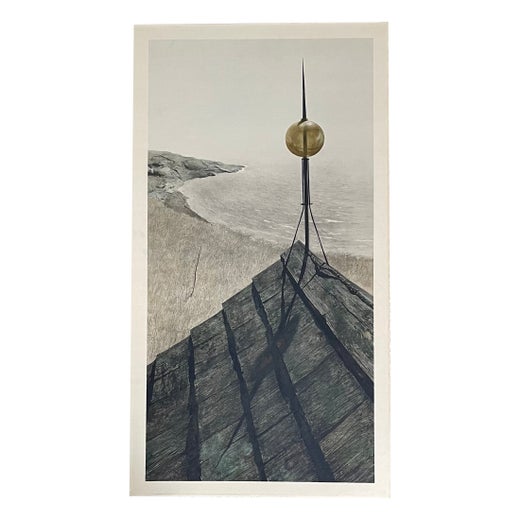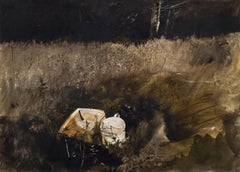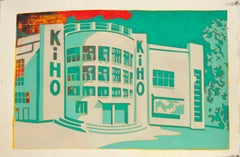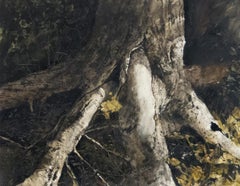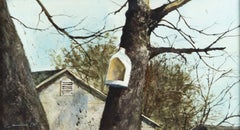Want more images or videos?
Request additional images or videos from the seller
1 of 8
Andrew WyethAlbinos Study2002
2002
About the Item
- Creator:Andrew Wyeth (1917-2009, American)
- Creation Year:2002
- Dimensions:Height: 13.75 in (34.93 cm)Width: 20 in (50.8 cm)
- Medium:
- Period:
- Condition:
- Gallery Location:Palm Desert, CA
- Reference Number:Seller: 40541stDibs: G12091093285
Andrew Wyeth
An artist who pursued his own course when the rest of the art world was consumed with modernism and abstraction, Wyeth is considered among the preeminent representational painters of the 20th century. Born in Chadds Ford, Pennsylvania, Wyeth drew his subject matter from the world around him: the interiors and exteriors of the stone buildings, mills, and farms of the Brandywine River countryside, and in the summers, the clapboard houses and stark landscape of the Maine coast. After his father died in a 1945 automobile accident, Wyeth began to incorporate people into his pictures, most notably Christina Olson, and later Siri Erickson, of Cushing, Maine, and his Chadds Ford neighbors Karl and Anna Kuerner and Helga Testorf. The first visual artist to appear on the cover of Time magazine, Wyeth was also the first living American-born artist to be given an exhibition at The Metropolitan Museum of Art in New York. Wyeth’s naturalistic style is marked by strong editing combined with remarkable execution of details. While relying on keen visual observation, he pared down the elements of a composition to their most essential, giving his works an abstracted quality and imbuing them with a sense of quietude and stillness. The egg tempera medium (which he came to prefer to oil after first experimenting with it in the early 1940s) lent itself to the precise detailing required to create his subtle textural effects, since it dries quickly and translucent layers can be built up over one another. Wyeth also painted extensively in watercolor in works of more spontaneous execution, as well as in the drybrush technique (where most water is removed from the watercolor medium), sometimes combining the two.
About the Seller
4.8
Recognized Seller
These prestigious sellers are industry leaders and represent the highest echelon for item quality and design.
Established in 1996
1stDibs seller since 2011
113 sales on 1stDibs
Typical response time: 2 hours
Authenticity Guarantee
In the unlikely event there’s an issue with an item’s authenticity, contact us within 1 year for a full refund. DetailsMoney-Back Guarantee
If your item is not as described, is damaged in transit, or does not arrive, contact us within 7 days for a full refund. Details24-Hour Cancellation
You have a 24-hour grace period in which to reconsider your purchase, with no questions asked.Vetted Professional Sellers
Our world-class sellers must adhere to strict standards for service and quality, maintaining the integrity of our listings.Price-Match Guarantee
If you find that a seller listed the same item for a lower price elsewhere, we’ll match it.Trusted Global Delivery
Our best-in-class carrier network provides specialized shipping options worldwide, including custom delivery.You May Also Like
Colorful Corals, Marine Diptych, Vivid Tones Reef, Acrylic Painting on Paper
Located in Barcelona, ES
Colorful Corals II is a vibrant diptych that captures the rich diversity and texture of underwater coral life. The artist uses confident lines and bold, layered colors—reds, blues, y...
Category
2010s Naturalistic Landscape Paintings
Materials
Paper, Acrylic, Gouache
Cotman, Norwich School, Early English Watercolor of Rouen, France
By John Sell Cotman
Located in Harkstead, GB
A beautiful composition capturing one of the well known buildings of Rouen, a city that was very popular with early 19th century watercolour painters. John Sell Cotman painted this v...
Category
Early 19th Century Victorian Landscape Drawings and Watercolors
Materials
Paper, Watercolor
$1,610
H 3.5 in W 4.75 in D 1 in
John Joseph Cotman, Norwich School, Early English Watercolor
Located in Harkstead, GB
A beautiful little gem of a watercolour with bold palette and most attractive composition. A rare and fabulous work by the talented son of John Sell Cotman.
John Joseph Cotman (1814...
Category
Early 19th Century Victorian Landscape Drawings and Watercolors
Materials
Paper, Watercolor
$915 Sale Price
30% Off
H 3.5 in W 4.75 in D 1 in
Frank Richards, Newlyn School, English Watercolor of Pyramids at Giza, Egypt
By Frank Richards
Located in Harkstead, GB
A very striking image of the Pyramids of Giza at sunset with a felucca drifting by on the Nile. A most attractive palette and image with the ripples on the surface of the river and w...
Category
1880s Victorian Landscape Drawings and Watercolors
Materials
Paper, Watercolor
$915 Sale Price
30% Off
H 3.75 in W 5.75 in D 1 in
Early English watercolour of pheasants in a woodland setting
Located in Harkstead, GB
A very attractive images of pheasants in a woodland setting with strong colour and composition.
Newton Smith Limbird Fielding (1799-1856)
Cock pheasant and hen against a sandy bank
...
Category
Early 19th Century Victorian Landscape Drawings and Watercolors
Materials
Paper, Watercolor
$915 Sale Price
30% Off
H 6 in W 8 in D 1 in
Two English watercolours, Norfolk Windmill; Fishermen mending nets on the shore
By Charles Robertson
Located in Harkstead, GB
Two delightful watercolours, with wonderful details by the highly collectable Charles Robertson. They depict two different aspects of Victorian life, the first captures two boys fis...
Category
Late 19th Century Victorian Landscape Drawings and Watercolors
Materials
Paper, Watercolor
$1,020 Sale Price
20% Off
H 6.5 in W 4 in D 1 in
Untitled: Abstract Figure and Leaves
By Gio Colucci
Located in Berlin, MD
Gio Colucci (Italian 1892-1974) Untitled: Abstract Figure and Leaves. Gouache on paper laid down on matt board. Archival framing under glass. Originally from the Con-Agra Corporat...
Category
Early 20th Century Abstract Figurative Paintings
Materials
Gouache, Laid Paper
Megalopolis Lights - 21st Century, Contemporary, Landscape, Watercolor on Paper
By Ekaterina Smirnova
Located in Barcelona, Catalonia
Atmosphere -masses of evaporating water in the air- describes Ekaterina Smirnova's paintings best. Working in watercolour, Smirnova has a unique approach to this traditional medium. ...
Category
21st Century and Contemporary Contemporary Landscape Drawings and Waterc...
Materials
Paper, Watercolor
$12,568
H 50.01 in W 79.93 in
Rainy Way 5 - 21st Century, Contemporary, Landscape, Watercolor on Paper, Bridge
By Ekaterina Smirnova
Located in Barcelona, Catalonia
Watercolour on paper
Atmosphere -masses of evaporating water in the air- describes Ekaterina Smirnova's paintings best. Working in watercolour, Smirnova has a unique approach to thi...
Category
21st Century and Contemporary Contemporary Landscape Drawings and Waterc...
Materials
Paper, Watercolor
$4,742
H 29.14 in W 43.31 in
Barcelona 9pm - 21st Century, Contemporary, Landscape, Watercolor on Paper
By Ekaterina Smirnova
Located in Barcelona, Catalonia
Atmosphere -masses of evaporating water in the air- describes Ekaterina Smirnova's paintings best. Working in watercolour, Smirnova has a unique approach to this traditional medium. ...
Category
21st Century and Contemporary Contemporary Landscape Drawings and Waterc...
Materials
Paper, Watercolor
$11,264
H 51.97 in W 70.08 in
More From This Seller
View AllQuart and a Half
By Andrew Wyeth
Located in Palm Desert, CA
"Quart and a Half" is an American Realist abstract landscape watercolor on paper painting by Andrew Wyeth in 1961. The artwork is 21 x 29 1/4 inches and is 33 3/4 x 42 1/4 x 1 inches...
Category
20th Century American Realist Landscape Paintings
Materials
Paper, Watercolor
Kiho
By Eric Jon Holswade
Located in Palm Desert, CA
A flashe and gouache on paper painting by contemporary artist Eric Jon Holswade. "Kiho" depicts the architecture of the Kiho building and is executed in greens and reds against a neu...
Category
21st Century and Contemporary Contemporary Landscape Paintings
Materials
Gouache, Paper
Exposed, Uprooted
Located in Palm Desert, CA
A painting by Gregory Sumida. “Exposed, Uprooted” is a landscape painting, watercolor on paper in an earth-tone palette by American artist Gregory Sumida. The artwork is signed in th...
Category
Mid-20th Century Contemporary Still-life Paintings
Materials
Watercolor
Plastic Feeder, Lockford, CA
Located in Palm Desert, CA
A painting by Gregory Sumida. “Plastic Feeder, Lockford, CA” is a landscape painting, watercolor on paper in an earth-tone palette by American artist Gregory Sumida. The artwork is s...
Category
Late 20th Century Contemporary Landscape Paintings
Materials
Watercolor
Tree Study, Whittier, CA
Located in Palm Desert, CA
A painting by Gregory Sumida. “Tree Study, Whittier, CA” is a landscape painting, watercolor on watercolor board in an earth-tone palette by American artist...
Category
Mid-20th Century American Modern Landscape Paintings
Materials
Watercolor
Geese
Located in Palm Desert, CA
A painting by Gregory Sumida. “Geese” is a landscape painting, watercolor on paper in an earth-tone palette by American artist Gregory Sumida. The artwork is signed in the lower left...
Category
Late 20th Century American Modern Figurative Paintings
Materials
Watercolor
$12,500
Recently Viewed
View AllRead More
Penelope Gottlieb’s Comic-Style Painting Is a Requiem for a Vanished Flower
This piece may look like Pop art fun, but embedded within is a message of a planet on the brink.
10 Reasons Art Collectors Are Obsessed with Andy Warhol
More than three decades after his death, the prolific Pop artist and cultural icon's body of work continues to captivate. Here's a primer of some of his most notable motifs and mediums.
More Ways To Browse
Andrew Wyeth Studys
Rural Landscape Painting
Water Ripple
Desert Painting
Modern Original Oil Paintings
Oil Can
Oil Cans
Outsider Artist
Montmartre Paris
Pastoral Landscapes
19th Century Large French Oil Painting
African Art Canvas
Aix En Provence
New Orleans Artist
Scottsdale Arizona
The Clash
Used Greenhouses
A Pair Of Paintings
